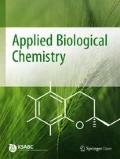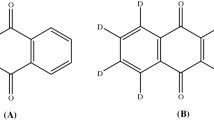Abstract
The present study estimated the residue levels of abamectin (B1a) in green tea leaves and tea infusion. Samples were hydrated with water prior to extraction by using the quick, easy, cheap, effective, rugged, safe method and was analyzed with liquid chromatography-tandem mass spectrometry in positive ion mode. The matrix-matched calibration was linear over the concentration range of 0.01–2mg/kg with determination coefficients (R 2) >0.995. Recovery rates at two spiking levels (0.1 and 0.5 mg/kg) ranged between 80.5–99.7% with a relative standard deviation <11%. The compound was stable at 20°C for 174 days with a recovery estimate of 109.9%. Although the maximum residue limit was not established by the Ministry of Food and Drug Safety, Republic of Korea, the limit of quantitation was very low at 0.01 mg/kg. The method was successfully applied to field incurred samples and detected residue of 0.02 mg/kg in green tea samples sprayed twice (7-3 days). Abamectin was not transferred to tea infusion.
Similar content being viewed by others
References
Abd El-Aty AM, Choi JH, Rahman MM, Kim SW, Tosun A, and Shim JH (2014) Residues and contaminants in tea and tea infusions: a review. Food Addit Contam. DOI: 10.1080/19440049.2014.958575.
Anastassiades M, Lehotay SJ, Štajnbaher D, and Schenck FJ (2003) Fast and easy multiresidue method employing acetonitrile extraction/partitioning and “dispersive solid-phase extraction” for the determination of pesticide residues in produce. J AOAC Int 86, 412–31.
Chen Q (1985) Tea-The best drinking for health. China Tea 3, 28.
Cho SK, Abd El-Aty AM, Rahman MM, Choi JH, and Shim JH (2014) Simultaneous multi-determination and transfer of eight pesticide residues from green tea leaves to infusion using gas chromatography. Food Chem 165, 532–9.
Gupta M and Shanker A (2009) Fate of imidacloprid and acetamiprid residues during black tea manufacture and transfer into tea infusion. Food Addit Contam 26, 157–63.
Kottiappan M, Anandhan SV, and Chandran S (2013) Estimation of Abamectin Residues Present in Tea: High-Performance Liquid Chromatography Technique. ISRN Chromatogr. Doi:10.1155/2013/183.
Kumar V, Tewary DK, Ravindranath SD, and Shanker A (2006) Investigation in tea on fate of fenazaquin residue and its transfer in brew. Food Chem Toxicol 44, 596–600.
MacBean C (2012) In The Pesticide Manual, (16th ed.), British Crop Production Council, UK.
Nagayama T (1996) Behavior of Residual Organophosphorus Pesticides in Foodstuffs during Leaching or Cooking. J Agric Food Chem 44, 2388–93.
Park KH, Choi JH, Abd El-Aty AM, Rahman MM, Jang J, Ko AY, Kwon KS, Park HR, Kim HS, and Shim JH (2013) Quantifying fenobucarb residue levels in beef muscles using liquid chromatography-tandem mass spectrometry and QuEChERS sample preparation. Food Chem 138, 2306–11.
Rajski £, Lozano A, Belmonte-Valles N, Uclés A, Uclés S, Mezcua M, and Fernandez-Alba AR (2013) Comparison of three multiresidue methods to analyse pesticides in green tea with liquid and gas chromatography/tandem mass spectrometry. Analyst 138, 921–31.
SANCO (2009) Document No. 10684. Method validation and quality control procedures for pesticide residues analysis in food and feed, National Food Administration, Sweden.
Sharma A, Gupta M, and Shanker A (2008) Fenvalerate residue level and dissipation in tea and in its infusion. Food Addit Contam Part A Chem Anal Control Expo Risk Assess 25, 97–104.
Wislocki PG, Grosso LS, and Dybas RA (1989) Environmental aspects of abamectin use in crop protection. In:(ed) Ivermectin and abamectin, Campbell WC, pp. 185–200, Springer Verlag, USA.
Yang A, Abd El-Aty AM, Park JH, Goudah A, Rahman MM, Do JA, Choi OJ, and Shim JH (2014) Analysis of 10 systemic pesticide residues in various baby foods using liquid chromatography-tandem mass spectrometry. Biomed Chromatogr 28, 735–41.
Yang F, Yang S, Lin Y, Zheng D, Lu S, Huang Z, and Zhang Y (2009) Determination of avermectin residues in tea by ultra-performance liquid chromatography-electrospray tandem mass spectrometry. Se Pu 27, 153–7. (Article in Chinese)
Author information
Authors and Affiliations
Corresponding authors
Rights and permissions
About this article
Cite this article
Kim, SW., Abd El-Aty, A.M., Choi, JH. et al. Analysis of abamectin residues in green tea using QuEChERS method and liquid chromatography-tandem mass spectrometry. J Korean Soc Appl Biol Chem 57, 783–787 (2014). https://doi.org/10.1007/s13765-014-4209-7
Received:
Accepted:
Published:
Issue Date:
DOI: https://doi.org/10.1007/s13765-014-4209-7




